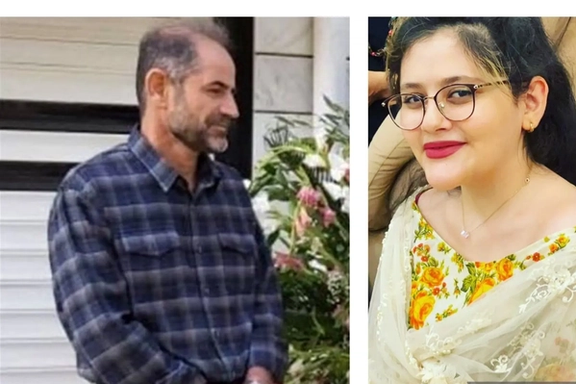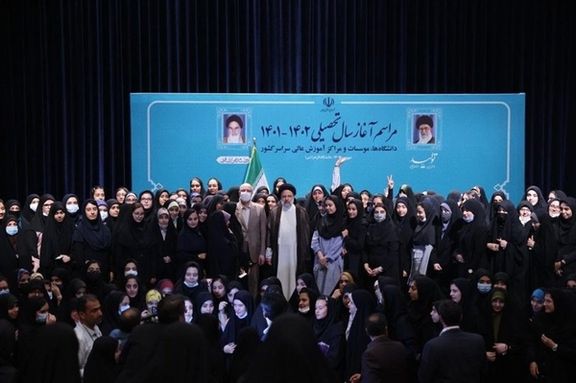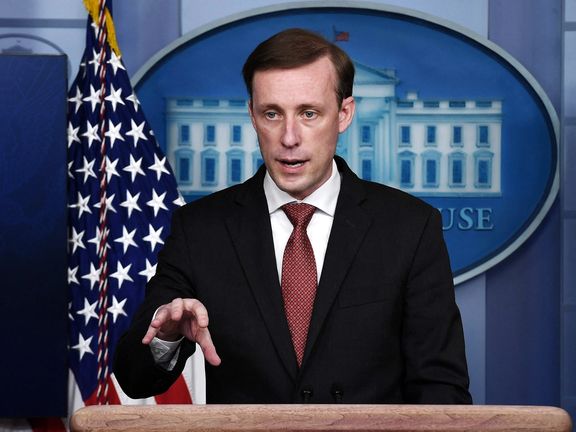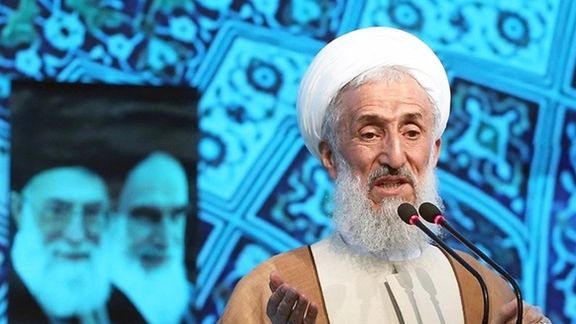Mahsa Amini’s Father Rejects Coroner's Report About Her Death

Amjad Amini, the father of Mahsa, the young woman whose death sparked the uprising in Iran, has rejected Iranian coroner's report that her daughter did not die du blows to her head.

Amjad Amini, the father of Mahsa, the young woman whose death sparked the uprising in Iran, has rejected Iranian coroner's report that her daughter did not die du blows to her head.
In an interview with Iran International, he denied the forensic report about the cause of his daughter's death and said that he has repeatedly requested to publish the video of his daughter's arrest, but the authorities have not done it yet.
He added that "I saw with my own eyes that blood had come from Mahsa's ears and back of her neck."
He had earlier said that he held the police responsible for her death.
About three weeks after Mahsa death, the Iranian Legal Medicine Organization announced on Friday that her death was "not caused by blow to the head and limbs" but by multiple organ failure caused by cerebral hypoxia. It did not say whether she had suffered any injuries. The report did say she fell while in custody due to "underlying diseases".
Amini’sdeath while in the custody of Iran's morality police has ignited three weeks of nationwide protests. Young women and men have simply rebelled against enforcement of restrictive Islamic rules on their lifestyles and demand an end to religious government.
Iran International obtained Amini’s brain CT scan from hospital sources in September that shows bone fracture in the skull, hemorrhage and brain edema, Iran International has learned.

Iranian security forces opened fire at protesters in two Kurdish cities on Saturday amid nationwide protests that started at universities in the morning and are continuing on streets.
"Security forces are shooting at the protesters in Sanandaj and Saqqez," said the Hengaw Organization for Human Rights, a Kurdish rights group. The widely followed 1500Tavsir Twitter account also reported shootings at protesters in the two western Kurdish cities.
Hengaw also published a video of a driver who was shot dead by security forces just because he was showing his protest with a long honk.
High school students in Sanandaj have joined the demonstrations, chanting, "Women, Life Liberty" while there was also a general strike in the city with all shops closed.
Oslo-based organization Iran Human Rights said on Saturday that at least 185 people have been killed in the uprising ignited by the death in custody of 22-year-old Mahsa Amini. The NGO added that about 20 of the killed were minors.
The protests first erupted in Mahsa Amini’s hometown Saqqez and capital Tehran and soon spread to all over the country and garnered support from Iranian expatriate communities around the world as well as foreign governments and officials.
The Persian hashtag to express support for the protests has been retweeted over 270 million times and is still being used.

Hundreds of students held a protest at Al-Zahra University -- a female-only public university – against Ebrahim Raisi while the president was speaking to his cherrypicked supporters inside a hall.
Raisi visited the university on Saturday while anti-government protest rallies were being held on several campuses across the country.
Al-Zahra University students, who were not allowed in the hall where Raisi was delivering a speech, gathered outside the venue and chanted slogans against Raisi and the clerical regime such as "Raisi, get lost."
Iranian activists and university professors called for nationwide rallies on Saturday, October 8, as street protests have become sporadic in recent days. In a statement Thursday, professors at the prestigious Sharif University of Technology in Tehran also urged all students and professors to rally in universities across the country in protest to the plainclothes security forces’ brutal attack on their university’s students October 2.
By noon, videos on social media show police using tear gas near Sharif University, and gunshots are also heard around the university.
Students, mostly girls, in secondary schools, which only opened a few days ago for the new academic year, rebelled this week in many areas, refusing to attend classes, protesting inside their schools and chanting slogans on their way home. Students often burn the headscarves they are forced to wear, in protest to hijab laws and the killing of Mahsa Amini who was arrested in September for her "improper hijab”.
Iranian authorities have clamped down on the protesters with such heavy methods that even some of their own supporters find it hard to digest.

White House National Security Advisor Jake Sullivan said on Friday that he spoke with Iranian women’s and human rights activists about how the US can continue to support protestors in Iran.
In a tweet, Sullivan also called for justice over the death of Mahsa Amini, killed in the custody of Iran's "Morality" Police. The young woman’s death sparked the current nationwide protests.
Earlier in the day, US Envoy for Iran Rob Malley told NPR that "What the US wants is a government in Iran that respects people's fundamental rights. It's not a policy of regime change. It's a policy of backing people who're protesting peacefully, because they want to be able not to wear a headscarf yet face an oppressive system."
The United States on Thursday imposed sanctions on seven Iranian officials over the shutdown of internet access and the crackdown on peaceful protesters.
The US Treasury Department in a statement said it imposed sanctions on Iran's minister of interior, Ahmad Vahidi; Communications Minister Eisa Zarepour; and Vahid Mohammad Naser Majid, the head of the Iranian Cyber Police, among others.
The European Union and its member states are also putting significant pressure on Iran, by foreign ministers telling Tehran to stop its mistreatment of citizens. However, Iran’s foreign minister Hossein Amir-Abdollahian has dismissed such calls, insisting that women are protected in his country and others should not intervene.

Iran's top clerics, police chiefs and Friday imams spurned nationwide protests and attributed the ongoing uprising to foreign countries and economic problems.
During a meeting with Iran's Police Chief Hossein Ashtari in Qom on Friday, hardline Ayatollah Naser Makarem Shirazi said the protests were the outcome of financial problems, people's access to social media and the intervention of foreign powers. He added that protests are likely to continue as long as these three elements exist.
Meanwhile, the ayatollah, who has been previously implicated in financial corruption cases, thanked the police for suppressing the protests.
Reports from Iran say the police chief has told the ayatollahs in Qom that the so-called morality police will resume its activities in November. The 22-year-old Mahsa Amini’s death in custody of the morality police in mid-September triggered the protests that are continuing in Iran for the third consecutive week and have turned into a nationwide uprising.
In another development, while all the footage on social media show the police and Basij militia firing shotguns at people at close range, Police Chief Hossein Ashtari claimed before the Friday prayers in Tehran that security forces have been using only plastic bullets. Meanwhile, he claimed that the police has arrested 17 protesters who were armed with combat weapons.

However, he confirmed that the police use live combat ammunitions while defending their headquarters. He further claimed that the police had done nothing wrong in the episode during which Mahsa Amini was killed. Ashtari further blamed foreign countries particularly the United States and Israel, monarchists and the Iranian opposition for engineering the protests. These are the usual suspects Iranian authorities blame for every problem from COVID-19 to the Iranian youths' disillusionment.
Former intelligence minister Ghorban Ali Dorri Najafabadi, who also made exactly the same accusations, also added that authorities were able to suppress and end the protests. While large street demonstrations have decreased since October 2, smaller manifestations, strikes and civil disobedience continue in many cities.
Friday prayer imams also continued their usual disinformation and misinformation about the nationwide protests. Kazem Sedighi, the Friday Imam in Tehran also blamed the United States and Israel for the nationwide uprising. He also charged some other regional states with instigating havoc in Iran. He said the protests were the work of infidels and imperialists. This comes while in recent days school children in Iran were most active in the uprising and the regime's security forces have killed at least 6 of them and claimed that they died in various accidents.
The imam in Qom, Alireza Arafi and the Friday prayers imam of Isfahan Abolhasan Mahdavi also blamed foreign-based Persian media as well as foreign countries as the main culprits behind the uprising. The Imam in Mashhad, the firebrand Ahmad Alamolhoda, however, as usual blamed Iranian women for every problem in the country and opined that "bad-hijab women give way to widespread promiscuity, abnormal sexual tendencies and Satanic liberties."
He charged that "the enemy which is against Iran's power and progress in technology, is behind the sedition that propagates the idea of doing away with hijab as a prelude to uprooting Islam in Iran."
It is hard to judge whether the Iranian clerics are truly overwhelmed by illusions and conspiracy theories, or they know the truth, but simply try to protect the establishment that feeds them and provides them with large financial resources they could not otherwise have.

The French Foreign Ministry has urged all its nationals to "leave Iran as soon as possible given the risk of arbitrary detention to which they are exposed."
"Any French visitor, including dual nationals, is exposed to a high risk of arrest, arbitrary detention and unfair trial," read a Friday statement by Paris.
Earlier Thursday, Paris condemned Tehran for airing a video of a French couple, who say they are spies of the French intelligence service.
In order to build a narrative of foreign engendered protests, Iranian state media on Thursday released a trailer of an apparently longer program featuring forced confessions of Cécile Kohler, an educator who heads the teachers’ union National Federation of Education, Culture and Vocational Training (FNEC FP-FO) and her husband Jacque Paris.
In the short clip, they say they are agents of the French intelligence service, and were sent to Iran to prepare grounds for riots. State TV said the two French citizens had entered Iran with "chunks of money ... which was meant to fund strikes and demonstrations." "Our goal at the French security service is to pressure the government of Iran," said Paris in the video.
Moreover, the Dutch government on Friday urged all Dutch nationals to leave Iran and advised against all travel to the country, Dutch news agency ANP quoted Foreign Minister Wopke Hoekstra as saying.